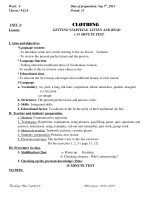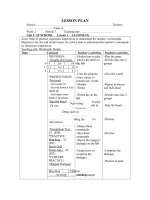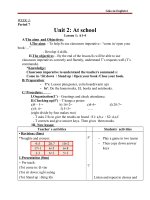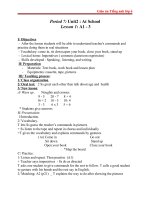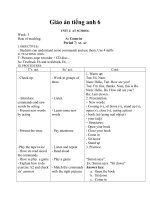Giáo án Tiếng Anh 9 Unit 2: Clothing
Bạn đang xem bản rút gọn của tài liệu. Xem và tải ngay bản đầy đủ của tài liệu tại đây (166.76 KB, 28 trang )
Giáo án Tiếng Anh 9
UNIT 2: CLOTHING
Theme: Personal information
Topic: Clothing
LESSON 1: GETTING STARTED & LISTEN AND READ (P.13 – 14)
I.OBJECTIVES: By the end of the lesson, Ss will be able to ask and respond to questions on
person preferences. Especially the traditional clothes of some countries all over the world and
Viet nam.
II. LANGUAGE CONTENTS:
Grammar: - The passive ( review) - The present perfect ( review )
Vocabulary : - poet (n), a long silk tunic (n), loose, pants (n), fashion(n), poetry
III. TECHNIQUES: Crossword, answer given . . . .
IV. TEACHING AIDS:Pictures, books , chalk, tape, cassette . . .
V. PROCEDURE:
T’s and Ss’ activities
Content
1. WARM UP : * Chatting :
- T asks Ss some questions .
I. Getting started
- Ss answer freely.
- Where does she come from?
- T says “ Today we’ll learn about the
- Why do you know she come from?
traditional costumes of some countries.
First, you look at the dress that some
people are wearing. Decide where each
* New words:
- Kimono (n) ( picture): áo kimono
T
10’
person comes from “
- Then Ss look at the pictures in book
- Sari (n) : ( picture) : áo quấn quanh người thay
quần áo
and answer.
- Veil (n) ( picture) : mạng che mặt
- T gives some new words
- Kilt (n) ( picture) : váy của người miền núi
- T reads twice and Ss repeat
- Ss take note.
- T checks by playing “ Slap the
board”.
( Slap the board )
The answer
- She comes from Japan. She is wearing a
Kimono.
- She comes from Viet Nam. She is wearing Ao
dai.
- T asks Ss look at the pictures in book
to tell where they come from.
- Some Ss give the answer before the
class.
- T corrects
- Ss take note.
- He comes from Scotland. He is wearing a kilt.
- She comes from India. She is wearing a sari
- He comes from the USA. He is wearing the
Cowboy.
- She comes from ( Saudi) Arabia. She is
wearing a Veil.
- What material is Ao dai made from?
- Who wear Ao dai? Is modern Ao dai different
from the old one?
- T says “As you know, Ao dai is the
traditional dress of VN. So what do you
know about Ao dai?”
- Ss answer freely.
II. LISTEN AND READ
1. New words :
- Poet (n) ( Ng.Du, To Huu are poets) : nhà thơ
- Loose pants ( n) (picture): quaàn roäng
5’
- T opens the tape once and gives new
words on the board.
- Ss guess meaning of new words, then
take note.
- T reads new words twice
- Ss listen carefully and repeat (whole
- A long silk tunic ( n) ( picture) : áo lụa dài
- Fashion (n): (tranlation): thời trang, mốt
- Fashionable (adj) (tranlation): thời trang
- Poetry (n) ( situation): thơ ca, thơ văn
- Inspiration (n) (relation): cảm hứng
the class )
- Symbol (n): (relation) : biểu tượng
- Ss read individually before the class.
- Pattern (n) (situation): mẫu vẽ
- T checks new words by playing
- Unique (adj): (traslation): độc đáo, có một
“ Rub out and remember”
không hai
( Rub out and remember)
2.The grammar : The present prefect
S + HAVE/HAS + V (ed/c3) + . . .
- T explains the grammar “ the present
perfect”.
- Ss listen carefully and take note.
- T opens the text again.
5’
Ex: Some have printed lines of poetry on the
Ao dai.
3 . PRACTICE :
a) Complete the sentences. Use the information
from the passage.
- Ss listen and read the text
(individually) .
- T corrects pronunciation
1. For a long time the ao dai has been the
subject of poems, novels, and songs.
2. The ao dai is described as a long silk tunic
with slits up the sides worn over loose
pants.
LUCKY NUMBERS
3. The majority of Vietnamese women prefer
to wear modern clothing at work.
4. Some designers have modernized the ao dai
10’
by printing lines of poetry on it.
1
2
4
5
3
6
5. Another alternative is to add symbols such
as suns, starts, crosses and stripes.
6. Lucky number
7. lucky number.
Ss work in group to complete the
sentences.
b) Answer the questions:
The answer:
1. Traditionally, men and women used to wear
- Ss give the keys on the board.
the Ao dai
- T corrects by playing “ Lucky
2. Because it is more convenient
numbers”
- Ss take note.
3. They have printed lines of poetry on it or have
added symbols such as suns, starts, crosses, and
stripes to the “ Ao dai”
- T says “Now you read the text again
4. PRODUCTION :
and answer the questions in b)”
Answer the questions:
- Ss work in close pairs or open pairs.
a) Do you like wearing Ao dai?
- Ss give the answer on the board.
b) Do you like wearing Ao dai flower and Ao dai
- T corrects
- Ss take note.
5’
color?
c) What color is popular with students at high
school? With the middle age?
5. HOMEWORK:
- T gives some questions on the poster.
- Ss work in group and then give the
keys on before the class
- Learn new words and the grammar by heart.
- Read the passage many times.
- Do exercise: Supply the correct verbs
7’
1. They ( just meet ) him at the airport.
- T gives the homework on the board.
2. She ( buy ) a new bike last month ago.
- Ss take note
3. Nam often ( watch ) TV after school.
- Do exercise 1 on pages 12, 13 in Ex. book
- Prepare Unit 2 Lesson 2: Speak
* Answer:
- What do you usually wear on the weekend?
Why do you wear these clothes?
UNIT 2:
CLOTHING
Theme: Personal information
Topic: Clothing
LESSON 2 : SPEAK (P.14 – 16)
I. OBJECTIVESS :
By the end of the lesson, Ss will continue to learn about customs, especially, that is
casual clothes and favorite clothes.
II. LANGUAGE CONTENTS:
Grammar: - the present perfect ( review)
- the simple present ( review )
3’
Vocabulary :
- Sleeved (adj) Shorts (n)
, Plain (adj), Plaid (adj), Pants (n)
-Baggy (adj), Fade(v),
Blouse (n)
III. TECHNIQUES:
Noughts and crosses, matching.
IV. TEACHING AIDS:
Pictures , books , chalk, extra- board. ..
V. PROCEDURE:
1. Warm up: (5)
Write about the clothes:skirt, shirt, blouse, trousers...
2. Check up (5)
* Supply the correct verbs
1. I enjoy ( read) the comic book.
2. My father is used to ( get up) early.
3. I want ( visit ) Hue in this summer.
4. She (not do) her homework yet.
Ts and Ss activities
Content
UNIT 2:
CLOTHING
LESSON 2 : SPEAK
I . PRE SPEAKING :
1. New words :
- T asks Ss to look at page 14 in book
and says In the last lesson, we got
some information about Ao dai- the
- Suit (n) ( picture) : boọ y phuùc.
- Sleeveless (a) ( situation): khoõng coự tay, cuùt tay.
5
traditional dress of Viet Nam. Today
we will learn about the casual clothes
that we wear today”
- T gives new words by using pictures
- Pants (n) ( picture ): quần rộng
- Plaid ( a) ( situation) : trơn ( không có hoa)
- Plaid ( a) ( picture ) : kẻ ô vuông , kẻ ca-rô.
on page 14 in book.
- Fade (v) ( picture) : bạc màu, phai màu
- Ss look at them and give the name
- Baggy (a) ( action) : rộng thùng thình ( tả quần áo)
of the pictures.
- T corrects and Ss take note.
- T reads new words twice
- Ss listen carefully and repeat.
- T asks Ss to play “ Slap the board”.
- T- shirt (n) ( picture ): áo thung
- Sweater (n) ( picture ) : áo len
5’
( slap the board )
* MATCHING:
2. Match the phrases to the pictures
- T asks Ss to match the phrases to the
pictures.
- Ss do individually.
- Ss give the answer on the board.
- T corrects
- Ss take note.
- T asks Ss to read the survey in book
and explains the content of lesson. “
Picture
Name
A
1. a colorful-S-shirt
B.
2. a plaid skirt
C.
3. a plain Suit
D
4.a short –sleeved blouse
E
5.a sleeveless sweater
F
6.a striped shirt
G
7.baggy pants
H
8.faded jeans
I
9.blue shorts
Now you work in small groups and
look at the survey about the students
wear casual clothes, favorite clothes,
school uniform and clothes for special
occasions. First you discuss and write
two more questions for the last section
* The answer:
10’
of the survey”
A/1
D/ 3
B/5
E/ 8
G/ 7
H/ 2
II. WHILE – SPEAKING :
a. work in small groups. Write two more questions for the
- Then Ss work in group by answering
the questions
last section of this survey about students wear. Then
interview members of another group.
* Clothes for special occasions:
1.What type of clothing do you wear on Tet holiday?
- Ss in every group use the questions
in the survey to interview members of
another group.
Three people
said they like
their uniform
2.What do you wear when you go to a party?
b. Now report the results of your survey:
10’
Chi said
she loved
baggy
pants
- T goes around the class to help Ss.
Two people said they usually wore
colorful T-shirt on the weekend
- Ss give the keys on the board.
- Ss read the keys before the class.
III. POST – SPEAKING :
Put the clothes in the right sections
-A blouse
- a dress
-Swimming trunks
- a shirt
5’
-Slippers
- a handkerchief
- T gives the words on the extra-board. -A cap
- gloves
- Ss work in group
-Sandals
- a tie
- Some group give the answer on the
-Boots
- a skirt
board
- T corrects.
* The answer
Women’ s
Men’s
Footwear
accessories
clothes
clothes
A blouse
A shirt
Sandals
A cap
A dress
A tie
Slippers
A handkerchief
A skirt
Swimmi
Boots
ng
- Ss take note.
trunks
IV . HOMEWORK :
- T gives the homework on the board.
- Ss take note.
- Learn by heart new words and some name of clothes in
lesson
- Do exercises 2 ,3 pages 13/ 14/15 (ex. book)
- Prepare Unit 2: Lesson 3 Listen
New words
-
floral pants (n)
-
polka dot skirt (n)
UNIT 2:
CLOTHING
Theme: Personal information
Topic: Clothing
LESSON 3 : LISTEN (P.16 )
I. OBJECTIVES :
After finishing this lesson, Ss will continue learning about casual clothes, through
listening
II. LANGUAGE CONTENTS:
Grammar : - the past simple ( review)
Vocabulary: - floral pants (n), polka dot skirt (n)
III. TECHNIQUES:
-Networks , “ Slap the board”
IV. TEACHING AIDS:
-
Pictures , book, chalk, tape, extra- board
V. PROCEDURE: 1.WARM UP: (5’)
NETWORKS
Kind of clothes
2.CHECK UP:(5’)
* Put a preposition into each gap
1. What are you doing ? – I’m looking …… a pencil.
2. She is good…………….. Math.
3. They are interested…………… History
4. Mai is wait……………… at the bus station
5. He is keen………..film. (on )
* Use “ I wish” ( 3ms)
1. They don’t meet their parents. I wish…………..
2. I can’t buy this car. I wish ……………….
T’s and Ss’ activities
Content
T
UNIT 2: CLOTHING
T says “ In this lesson , you’ll hear a public
announcement about a lost little girl called
Mary. First you give name of the clothes in
the pictures”
- Ss look at the pictures and call name of the
pictures
- T gives new words and reads new words
LESSON 3 : LISTEN
I. PRE – LISTENING :
* New words :
- Floral pants (n) : the trousers have flowers : quaàn
boâng
- Polka dot skirt (n): ( picture): vaùy coù chaám bo
and old words twice.
- Ss listen and repeat.
- Ss take note.
- T and Ss play “ Matching”
- T asks Ss to look at the picture and guess
what Mary wears when she goes lost
* WHILE – LISTENING
* Guessing :
a) …………… b) ………………. c)
………………..
10’
- Ss listen to the tape twice.
II. WHILE – LISTENING :
- Now you listen to the tape again and
* The answer
check the letter of the correct picture to
a/ B ( she’s wearing the blue short)
show what Mary is wearing.
- Ss listen the tape once and check the letter
b/ A ( she’s wearing a long – sleeved with blouse )
10’
c/ C ( she’s wearing brown shoes)
- Then Ss compare the keys with classmates
- Ss listen again to check the answer and
give the answer on the board.
- T corrects
- Ss take note.
* Correct the guessing
a) ………….. b) ……………….. c) ………………..
- Ss correct the guessing .
* POST – LISTENING
- T gives some questions on the board.
- Ss listen to the tape again choose
True/False.
- Then Ss give the keys on the board.
III . POST – LISTENING:
True / false statements
- T corrects.
1/ Mary is three years old.
- Ss take note.
2/ She has a long dark hair.
3/ She ‘s wearing blue shorts and a long-sleeved
white blouse.
4/ Her mother is waiting for her
- T gives the homework on the board
* Answer:
10’
- Ss take note.
1) T
2) F
3) T
4)
IV. HOMEWORK :
- Learn new words by heart.
- Do exercises 4, 5 in Ex. book pages 15- 17
- Prepare Lesson 4 : READ
New words
- cotton (n)
UNIT 2:
- style ( n)
- label(n)
CLOTHING
Theme: Personal information
Topic: Clothing
LESSON 4: READ (P.17 – 18)
I. OBJECTIVES:
By the end of the lesson , Ss will be able to learn about history of Jeans.
II. LANGUAGE CONTENTS:
Grammar : - the simple past ( review )
- the simple present (review)
Vocabulary:
sailor (n) ,cloth (n),material (n), cotton (n),style (n), generation (n)
embroider (v), label (n), economic ( adj), out of fashion (n)
5’
III. TECHNIQUES :
Brainstorming, Rut out and remember , True/ false Repetition,
IV. TECHING AIDS:
Pictures, book, extra- board . . .. .
V. PROCEDURE:
1. WARM UP : BRAINSTORMING (5’)
+ Jeans:
- Easy to wear
- Convenient
- Fashionable
-Durable
2.CHECK UP:* Change the sentences into the passive voice (5’)
a. People grow rice in India.
b. My aunt makes this rug.
c. Mr Pike designed that bridge in 1970
d. They didn’t invite Bill and Ann to the party.
e. She taught English to her sister last year
3.NEW LESSON:
T’s and Ss’ activities
Content
- T says “We have discussed about Jeans,
UNIT 2:
In today’s reading , we’ll learn more
LESSON 4:
T
CLOTHING
READ
about the brief history of Jeans and its
conveniences “
PRE – READING
7’
- T reads the text once and gives new
words on the board.
I. PRE – READING :
* New words:
- Ss guess meaning of new words and
- Sailor (n): the person who works in the boat: thuỷ
take note.
thủ
- Then T reads new words twice
- Cloth (n) :( real object): vải
- Ss listen carefully and repeat.
- Cotton (n): (real object ) sợi bông
- T checks new words by asking Ss to
- Material (n): (translate ): chất liệu
play “ Rut out and remember”
- T asks Ss to guess the information in
lesson.
- Style (n): (translate) kiểu dáng
- Embroider (v) ( situation): thêu ( hoa văn, hình.)
- Lable (n) ( situation): nhãn hiệu
- Economic (adj): (translate) nền kinh tế.
- Out of fashion (n): no modern: lỗi thời
- Generation (n): ( situation) thế hệ
( Rut out and remember )
* Guessing game :
a) Fill in the missing dates and words
II. WHILE – READING :
a) Fill in the missing dates and words:
WHILE – READING
- T reads the text once
( correct the guessing game)
1.18th century: workers liked to wear jeans cloth
because the material made from cotton was very strong
and could hardly wear out.
15’
- Ss listen carefully and read individually
2.1960s:A lot of university and college students wore
(silent )
jeans
- T says “ Now you read the text again
3.1970s: Jeans became cheaper so many people began
and fill the missing dates and words”.
wearing jeans
- Ss work in group.
4.1980s : Jeans became high fashion clothing
- Ss work in group give the answers on
5.1990s: The sale of jeans stopped going up
the board.
b) Answer.
* The answer
- T corrects
- Ss take note
1.The words “Jeans” comes from a kind of material that
8’
was made in Europe.
2.The 1960s’ fashion were embroidered jeans , painted
jeans and so on
- Ss read the text again and answer the
questions.
- Ss work in close pairs or open pairs
- Some pairs practice asking and
answering the questions before the class.
- Ss give the answers on the board
- T corrects
3.Because jeans became cheaper
3.Jeans at last became high fashion clothing in the
1980s
5.The sale of jeans stopped growing because worldwide
economic situation got worse in the 1990s
III. POST – READING :
True/ false statements
- Ss take note
1. Many students wore jeans in 1990s
POST – READING
2. The word “ jeans” comes from a kind of material that
was made in Asia.
- T gives some sentences on the board
3. Today jeans are out of fashion.
4. In the 1970s more and more people liked wearing
5’
- Ss do exercises individually
jeans.
- Then Ss give the answers on the board
The answer
1. T
- T corrects
2. F
3. F
4. T
IV. HOMEWORK :
- Ss take note.
- Learn new words and the text by heart.
- Do exercises 6,7 in Ex. book pages 17,18
- Prepare Unit 2 Lesson 5: Write
- T gives the homework on the board.
- Ss take note.
+ Answer
- When do you wear jeans and T-shirt?
- When you go to the party, what do you wear?
UNIT 2:
CLOTHING
Theme: Personal information
Topic: Clothing
LESSON 5 : WRITE (P.18 – 19)
I. OBJECTIVES:
By the end of the lesson, Ss will be able to give their ideas to persuade readers to believe or
do something about secondary school students should wear uniforms.
II. LANGUAGE CONTENTS:
Grammar: - the simple present ( review)
Vocabulary:
-In conclusion , bear,equal, freedom,self – confident
III. TECHNQUES:
Balloon Debate, Survey
IV. TECHING AIDS:
Book, extra – board, chalk . . .
V. PROCEDURE:
1. WARM UP : (5’)T asks some questions
a.Do you like wearing uniform ? Jeans ? Casual clothes ?
b.Why or why not ?
2. CHECK UP: (5’)
* Write the sentences with “ I wish”
a. What a pity the weather isn’t nice
b. He doesn’t love his father
c. I’m sorry I can’t talk that with you
d. She runs quickly.
c. My younger sister studies English badly.
3. NEW LESSON:
T’ s and Ss’ activities
Content
UNIT 2: CLOTHING
- T says “ You have just argued with each
LESSON 5 : WRITE
T
other to protect your ideas and refute
I. PRE – WRITING :
others. In writing, there is a argumentative
cấu trúc
writing which presents one’s ideas,
opinions and make them persuasive to
Mở bài
Cho độc giả biết quan
readers. At the same time , this kind of
điểm của người viết
writing has to successfully protect its
( đồng ý hay không
opinion and refute the opposite ones. First
đồng ý)
you should understand clearly the
Thân bài
structure of the an argumentative writing .
( các ý tranh luận theo một cách logíc
it should have three parts as in the text
luận )
book”
quan điểm của người
viết
- Then Ss take note
talking about Secondary school students
Tóm tắt những ý đã
trình bày và khẳng đònh
- Ss look at three parts of the writing
read the Outline and the model writing
nhất, cung cấp dẫn
chứng khi cần thiết
Kết luận
- T asks Ss to look at the part a) in book,
Trình bày những ý tranh
Ngôn ngữ
My opinion is . . .. . .
should wear uniforms
I think . . . .. . .
- Ss note the words underlined in the
Firstly . . .. . . ..
writing.
Secondly . . . . .
Third . . . . . . . .
Finally . . .. . ..
Therefore . . . . . .
In conclusion . . . . .
* New words :
5’
- Proud of (n) ( situation) : tự hào
-T gives new words
- Ss guess meaning of the words
- T reads new words twice and Ss take
note.
- Ss play “ Rub out and remember”
- Bear(v) ( situation): mang, đeo (Ex: bear their
school’s name: thể hiện hình ảnh của
trường )
- Equal (n) ( situation) : bình đẳng
- Practice (n) ( tranlation) : thực tế
15’
- Freedom of choice (n) (tranlation): tự do lựa
chọn
- Self – confident (n) ( tranlation) : tự tin
( Rub out and remember )
II .WHILE – WRITING :
* The answer
In my opinion, secondary school students
WHILE – WRITING
should wear casual clothes.
Firstly, casual clothes make students feel
comfortable.
T says “ you have read an argument the
supports the idea the secondary school
should wear uniforms. Now use the
Outline B as the guidelines, write a
Secondly, wearing casual clothes gives students
freedom choice. They have rights to choose
sizes, colors and fashion that they love.
paragraph that supports the argument that
Thirdly, casual clothes makes students feel self-
secondary students should wear casual
confident when they are in their favorite
clothes.”
clothes.
- T asks Ss to write the passage about 15
Finally, casual clothes make school more
minutes ( individually )
colorful and lovely.
In conclusion, secondary school students should
10’
- Ss compare the answer with classmates
wear casual clothes. Wearing casual clothes is
convenient, comfortable and fun.
- T goes around the class and choose one
III. POST – WRITING :
or two passage in order to correct before
the class.
CLASSIFICTION
5’
Equal, comfortable, self – confident, proud,
practical, colorful, uniform, casual clothes,
lively
- T gives the answer on the board.
- Ss take note
For
Against
POST – WRITING
Proud
Comfortable
- T gives a lot of words which depend on
Equal
Self –confident
Practice
Colorful
Uniform
Casual clothing
two opinions “ for” or “ against” with
wearing uniform clothes.
lively
IV. HOMEWORK :
-Learn new words the report by heart
-T divide class into small groups, which
group does quicklier and the right is
winner.
- Ss practice freely
HOMEWORK
- T gives the homework on the board.
- Ss take note.
-Do exercise 8 in Ex. book page 18
-Prepare Language focus
- The present perfect with “ever,already” -The
simple past.
UNIT 2: CLOTHING
Theme: Personal information
Topic: Clothing
LESSON 6 : LANGUAGE FOCUS (P.19 – 21)
I. OBJECTIVES:
By the end of lesson, Ss will review the present perfect tense with “since, for, yet,
already”, and the simple past, the passive of the simple present, and Modal verbs.
II. LANGUAGE CONTENTS:
Grammar: - The present perfect, the passive voice, the simple past, Modal verbs.
Vocabulary: - Pagoda - Reunification Palace
- vegetarian
III. TECHNIQUES:
Classification, ask and answer.
IV. TEACHING AIDS:
Pictures, books, extra- board, chalk...
V. PROCEDURE:
I. Warm up:(5’) Classification
Last month, three days, 2005, yesterday, Monday, ten years, a week.
For
Three days
Since
Last month
Ten years
Yesterday
A week
Monday
2005
2. Check up: (5’) Fill in the gap.
a. Please pick me. . . . . at 7 pm.
b. He’s good . . . .Math.
c. Lan’s mother listen . . . . the radio.
d. Maryam is waiting . . you outside your school.
3.New lesson:
T’s and Ss’ activities
Content
UNIT 2:
LESSON 6 :
- T: uses the album has photos to ask Ss“ who
this boy is, and who these girls are”
CLOTHING
LANGUAGE FOCUS
I. Work with a partner. Read the dialogue
-
Nga: Come and see my photo album
- T: introduces the lesson: Mi is watching Nga’s
-
Mi : Lovely! Who’s this girl?
Album. Now you play the role of Mi and Nga
-
Nga: Ah! It’s Lan. My old friend
to talk about this Album.
-
Mi : How long have you known her?
-
Nga : I’ ve known her for six years
-
Mi : Have you seen her recently?
-
Nga : No, I haven’t seen her since 2003.
- Ss: practice the dialogue before the class
(close pairs and open pairs)
She moved to HCM city with her family
then.
The present perfect tense
- T explains the grammar
S + HAVE/ HAS + P.P + . . .
- Ss: take note
T
5’
- Then Ss use the information in the box and
make similar dialogue.
- Ss: work in close / open pairs
- Some pairs practice the dialogue before the
class.
Ex: I ( buy) this car for 2 years
I have bought this car for 2 years
I haven’t bought this car for 2 years
Have you bought this car for 2 years?
- T: corrects.
II. Work in a partner. Imagine you and your
partner are visiting HCM city. Ask and answer
- T: explains the present perfect tense with
questions about the things you have done.
“ Yet, already “
- Ss take note
+ Yet ( chưa): dùng ở câu phủ đònh
và nghi vấn. Đứng ở cuối câu
+ Already ( đã . .. rồi): dùng ở giữa
trợ động từ và động từ chính ( Have/ has
5’
already + pp )
* New words :
- T: explains new words
- T: reads new words twice
- Ss: guess meaning of new words and take
note.
Reunification Palace : Vinh thống nhất
-
Pagoda = temple : chùa
-
Zoo and Botanical Gardens : Thảo cầm
viên
-
Vegetarian : đồ chay
( Slap the board )
- T :checks the words by playing “ Slap the
Have you
board”
seen Giac
-T
-
Yes,
I’ve
work in pairs.
Imagine that
already
it city.
partner are visitingseen
HCM
Lam Pagoda
yet?“Now you
:says
you and your
Ask and answer the questions about the things
you have done.
Useeaten
the present perfect tense of
Have you
Vietnamese
the verbs in
the box”
food yet?
- Ss: work in close / open pairs
No, I
havent
III. Work with a partner.
* Ever ( tửứng, ủaừ tửứng): duứng trong caõu
Have / has + S + ever + P.P ?
- T: explains the present perfect tense with
hoỷi
ever
Yes, I have
Have you ever read
Ex:
Have
you
ever
visited
Hue
?
a comic ?
Yes, I have
When did you
- T: says last
you
work
the words to
read
it ?in pairs, use
This morning
ask and answer about yourself. Use the present
perfect tense of the verbs with
ever
- Ss: work in close / open pairs
- T: corrects
take note
Haveand
youSs
ever
been to
Singapore ?
No, I havent
5
IV.Use the passive form
* The answer
1. Jeans cloth was made completely from cotton
on the 18th century.
2. Rice is grown in tropical countries


